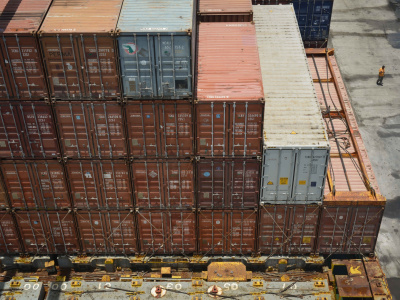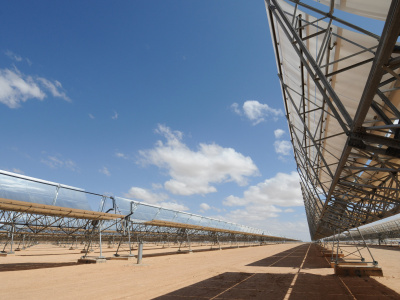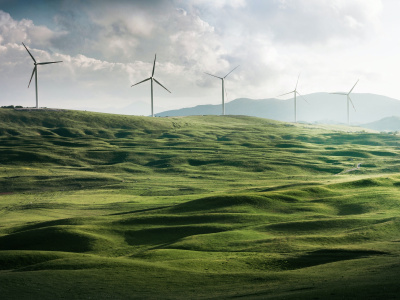
Navigating green economy and development objectives: Between ‘green’ and development narratives
African countries and economies are at the centre of competing demands and narratives around the global green transition. Bruce Byiers, Alfonso Medinilla and Karim Karaki identify the dilemmas they face in achieving ‘greener’ economic development pathways. In this first note out of a series of four, they zoom in on African narratives on climate and development.
Summary
African countries and economies find themselves at the centre of competing demands and narratives around the global green transition. The continent is rich in renewable energy sources and the minerals needed to power a global shift to clean energy while reducing, or avoiding greenhouse gas emissions is also seen by many as a risk to African economic development and akin to rich countries ‘kicking away the ladder’.
This note is part of a series of four notes and a synthesis paper, which identify and discuss the dilemmas faced by African countries in achieving ‘greener’ economic development pathways. This first note discusses ways to navigate the conflicting narratives on an African ‘just (energy) transition’.
The accompanying notes look at the increasingly complex effects of external climate regimes on African economies; the opportunities and risks for African countries linked to the energy transition and green industrial development; and the political economy dynamics and complexity of the green transition in practice, taking the case of transport in East Africa. The synthesis paper combines all four notes and identifies overarching recommendations and policy opportunities.
Introduction
African countries and economies find themselves at the centre of competing demands and narratives around the global green transition. The continent is rich in renewable energy sources and the minerals needed to power a global shift to clean energy, with several countries positioning themselves to take advantage of new opportunities and attract investment. At the same time, reducing, or avoiding greenhouse gas (GHG) emissions is also considered by many to be a risk for African economic development. As late industrialisers, African countries contribute less than 4% of global GHG emissions, and are now faced with increasing pressure to forgo a fossil fuel-driven industrialisation pathway. Some see this as rich countries ‘kicking away the ladder’ (Walsh et al. 2021) that they themselves used to develop, denying the continent a chance to leverage its own resources to catch up to the industrialised parts of the world. (1)
This note – part of a series of four notes and a synthesis paper (2) – discusses ways to navigate the conflicting narratives on an African ‘just (energy) transition’, and the challenge of economic development in a carbon-constrained environment.
The accompanying notes look at:
- the increasingly complex effects of external climate regimes on African economies;
- the opportunities and risks for African countries linked to the energy transition and green industrial development; and
- the political economy dynamics and complexity of green transition in practice for the case of transport in East Africa.
The following emerge as key takeaways from the four notes:
|
The remainder of this note unpacks African narratives on climate and development into four broad categories, arguing for the need to avoid the extremes in looking for green transition opportunities, even if these can help shape international negotiations.
Unpacking African narratives on climate and development
Economic development through increased productivity, trade and market integration have historically gone hand in hand with increased greenhouse gas (GHG) and other emissions. Simply put, more production, more trade, more emissions. While that has been the case, Africa as a whole, accounts for less than 4% of global GHG emissions, with most countries’ contributions being negligible on a global scale. (3) And as the world’s biggest emitters are seeking to reverse course, some fear that industrialisation and economic development in Africa will lead to a dramatic increase in GHG emissions (Moss and Ramachandran 2021). (4) Even without following the same carbon-intensive path as industrialised countries, rising trade and industrialisation as foreseen under the African Continental Free Trade Area (AfCFTA), is likely to increase GHG emissions from current levels. That raises questions around how these can be reconciled with greener industrialisation objectives and what that means for policymakers and their international partners.
COP27 discussions in Sharm-el-Sheikh in November 2022 underlined the different positions of developed and developing countries regarding the responsibility for reducing and limiting greenhouse gas emissions. The African Union (AU) and several African leaders advocated strongly for the use of Africa’s fossil fuels to kickstart Africa’s industrialisation and economic development while pointing fingers at European hypocrisy on fossil fuels, especially following the Russian war in Ukraine (AU 2022; Museveni 2022; Buhari 2022; Rolley 2022).
Africa’s right, and urgent need, to develop and industrialise is the starting point for all African leaders, yet African positions on the green transition and climate action are increasingly diverse. They cover a wide spectrum, ranging from an unapologetic ‘development first, climate later’ to a ‘generational case against fossil fuels’. These four key narratives, illustrated in Figure 1, are discussed below.

-
‘Development first, climate later’ is a common narrative, based on the moral argument that African economies have not contributed to global greenhouse gas emissions, and should not be subject to the same mitigation standards as other parts of the world. It argues for the use of Africa’s fossil fuel reserves to jumpstart its own industrialisation, and for channelling external investment into Africa oil and gas without export barriers for African industries. Leaders of emerging fossil fuel producing countries, including Mozambique, Uganda, Senegal, and the Democratic Republic of the Congo (DRC), all used elements of this narrative to call for a ‘fair energy transition’ at COP27, that enables them to develop their fossil fuel economies in the medium term, while balancing environmental and climate protection in the longer term (Rolley 2022; Museveni 2022; IISD 2022; Chakamba 2022). The ‘development first’ narrative is further supported by estimates by the United Nations Economic Commission for Africa (UNECA) and the International Energy Agency (IEA) that the effects of using African natural gas on global greenhouse gas emissions would be small (Songwe et al. 2022; Chakamba 2022).
-
‘Managing climate vulnerability’: This narrative is linked to the observation that African countries are vulnerable to climate change and extreme weather events, and an increasing concern with global inaction on climate change mitigation. It argues that African economic development and industrialisation will need to take account of, adapt to, and mitigate changing climatic conditions that are already felt through floods and droughts and their impacts on agriculture and people. But it is mostly concerned with securing financial support for climate change adaptation and the loss and damage caused by natural disasters, rising sea levels due to ongoing and future climate shocks. This requires significant investments in both resilience building and climate change adaptation, not least through a future loss and damage fund, as agreed at COP27. Africa’s distinct climate vulnerability also calls for closer alignment of climate and industrialisation agendas to enhance adaptation capacity in the productive and value added sectors (Said et al. 2022) (5).
-
‘Seizing green opportunities’: The green transition may offer opportunities for African countries. Several countries and industries are adopting a more optimistic approach that argues that African economies can leverage their renewable energy potential and mineral resources to play a lead role in a global green transition. The premise of this narrative is that the technology is available to enable African countries and particularly low- and middle-income countries (LMICs) to leapfrog from a fossil fuel based economy to cleaner alternatives (Walsh and Oguntoye 2022). Common commercial opportunities that countries see are linked to renewable energy production, both for exports and the production of green hydrogen. Countries like Kenya, Morocco and Egypt take this narrative further by presenting their countries as prime destinations for future investment in low-carbon industrial applications, and using their existing renewable energy capacity to promote external investment in clean energy and green hydrogen for powering industry transition, export to Europe, and green ammonia for decarbonising shipping (Ruto 2022a; Anouar 2022; Godinho and Eberhard 2019; Medinilla and Sergejeff 2023).
-
‘No fossil fuels’: While particularly associated with external, particularly European narratives, there is an increasingly vocal climate action community in Africa that argues a moral case against the development of Africa’s fossil fuel resources. At COP27, this was the call of the Don’t Gas Africa campaign, led by African climate groups. Some even called the AU’s pro-fossil fuel Common Position on Energy Access and Just Energy Transition (AU 2022) a betrayal of the African people (Adow 2022). Youth-led climate groups at COP27 made this into a generational struggle, calling out the long-term irresponsibility of future fossil fuel developments. The anti-fossil fuel narrative is supported by analysis that questions the medium-term commercial viability of large-scale investment in emerging African natural gas for exports and domestic consumption, especially as the demand from industrialised countries is set to fade out or peak in the coming decades (Anwar et al. 2022).
African economies may also benefit from greener industrialisation, building on cheap renewable electricity if they are able to position themselves in emerging green value chains, both in agricultural products and manufacturing.
All four of these narratives coexist in the public discourse of African leaders and policy makers. Though often disconnected from societal and firm-level interests, the more extreme, moral arguments (development first vs. no fossil fuels) play an important role in climate negotiations and arguably helped produce the breakthrough agreement on establishing a funding mechanism for loss and damage funding at COP27, even if the specific scope, parameters and modalities are yet to be defined (UNFCCC 2022). In some cases, however, those positions can polarise debates, emphasising tensions over opportunities. This is especially the case on energy and fossil fuels.
A less dogmatic approach acknowledges that there will always be an inherent tradeoff for African economies that seek to further industrialise in the 2020s and 2030s. This will mean balancing industrialisation agendas with the costs of climate change adaptation and the need to develop a more climate secure pathway. African economies may also benefit from greener industrialisation, building on cheap renewable electricity if they are able to position themselves in emerging green value chains, both in agricultural products and manufacturing (Triki and Said 2021; Jayaram et al. 2021). Framing the green transition as a matter of business opportunities, market access, costs savings, access to finance, and/or risk management, is more likely to get more traction beyond the direct climate action community, and offers more options to develop politically-informed, context-appropriate approaches to green economy transitions.
The AfCFTA and regional integration agendas may also help steer a more opportunity-focused approach to the climate agenda by facilitating more efficient (and therefore lower emission) transport systems serving larger markets and overcoming persistent trade barriers that stand in the way of scaling local productive capacity. While implementing the AfCFTA and regional trade agreements is subject to competing interests within and between states that can undermine their use (e.g. Apiko et al. 2020), the ability of African countries to take a more optimistic approach to the green transition also depends on a multitude of domestic structural, political, and economic factors, not least their existing energy assets (fossil fuel reserves, renewable energy potential), existing industries and exports. The importance of understanding these interests and incentives comes back as a common theme in the accompanying three notes.
Paper and other notes
This is the first note out of a series of four. In our paper, we combine the four notes and share overarching recommendations and policy opportunities. You can find the paper and the other notes here:
References
Adow, M. 2022. Outrage as African leaders seek to push for fossil fuel investment at COP27, 17 August 2022.
Anouar, S. 2022. Marrakech Offers 'Green' Investments at Investor Day, Morocco World News, 7 April.
Anwar, M., Neary, P. and Huxham, M. 2022. Natural Gas in Africa Amid a Global Low-Carbon Energy Transition, The African Climate Foundation, November 2022.
Apiko, P., Woolfrey, S. and Byiers, B. 2020. The promise of the African Continental Free Trade Area (AfCFTA), Discussion paper 287, ECDPM: Maastricht, December 2020.
AU. 2022. Africa Speaks with Unified Voice as AU Executive Council Adopts African Common Position on Energy Access and Just Energy Transition, press release, African Union, July 2022.
Avenyo, E.K., Tregenna, F. 2022. Greening manufacturing: Technology intensity and carbon dioxide emissions in developing countries, Applied Energy, Volume 324, 119726, ISSN 0306-2619, DOI 10.1016/j.apenergy.2022.119726.
Ayompe, L. M., Davis, S. J. and Egoh, B. N. 2021. Environmental Research Letters, Volume 15, Number 12, DOI 10.1088/1748-9326/abc64f.
BMZ. 2023. Global Shield against Climate Risks.
Buhari, M. 2022. Muhammadu Buhari: How not to talk with Africa about climate change, Opinion, Washington Post, 9 November.
Burn-Murdoch, J. 2022. Economics may take us to net zero all on its own, Opinion, Financial Times, 23 September.
Chakamba, R. 2022. Is natural gas the solution to Africa's 'energy poverty'? Devex, 10 November.
Chang, J-H. 2003. Kicking Away the Ladder: Development Strategy in Historical Perspective, Book.
Godinho, C. and Eberhard, A. 2019. Learning from Power Sector Reform Experiences. The Case of Kenya, Policy Research Working Paper 8819, World Bank Group, April 2019.
IISD. 2022. Daily report for 7 November 2022, Earth Negotiations Bulletin Vol. 12 No. 808, Sharm El-Sheikh Climate Change Conference, November 2022, International Institute for Sustainable Development.
Jayaram, K., Kendall, A., Somers, K. and Bouchene, L. 2021. Africa’s green manufacturing crossroads. Choices for a low-carbon industrial future, McKinsey&Company, September 2021.
Moss, T. and Ramachandran, V. 2021. Why the Climate Panic About Africa Is Wrong, Foreign Policy, 6 December.
Museveni, Y. K. 2022. Europe's Failure to Meet Its Climate Goals Should Not Be Africa's Problem, Opinion, Newsweek, 11 August.
Rolley, S. 2022. Congo rejects U.S. request to pull oil blocks from auction, Reuters, 5 October.
Ruto, W. 2022a. We are at a crossroads in history: Africa can and must be a leader in clean energy, The Guardian, 4 October.
Said, J., Akileswaran, K., Mazumdar, J. 2022. Industrialising Africa: Anchoring climate adaptation and the AfCFTA, IGC blog.
Songwe, V., Ogunbiyi, D. and Abou-Zeid, A. 2022. Africa’s energy transition calls for pragmatic measures to keep the continent competitive, UNECA stories.
Stern, D. I. 2018. The Environmental Kuznets Curve, in Reference Module in Earth Systems and Environmental Sciences.
Triki, C. and Said, J. 2021. Maximising the Green Path to Industrialisation in Africa, Tony Blair Institute for Global Change.
UNFCCC. 2022. COP27 Reaches Breakthrough Agreement on New “Loss and Damage” Fund for Vulnerable Countries, 20 November.
Walsh, G. and Oguntoye, O. 2022. Closing the Climate Divide: How Energy-Transition Plans Can Turn Pledges Into Projects, 9 November.
Walsh, G., Ahmed, I., Said, J., E Maya, M. F. 2021. A Just Transition for Africa: Championing a Fair and Prosperous Pathway to Net Zero, Tony Blair Institute for Global Change, October 2021.
Endnotes
1. The original idea of ‘kicking away the ladder’ comes from Ha-Joon Chang’s discussion of how developed economies used trade protectionism to develop, before promoting trade liberalisation (Chang 2003).
2. This paper is based on a desk review carried out in the second half of 2022, as well as a series of interviews with Kenyan stakeholders and experts carried out in November 2022.
3. Africa’s GHG emissions are highly concentrated in South Africa, Egypt, Algeria, Nigeria and Morocco, which account for over 75% of the continent’s total GHG emissions (Ayompe et al. 2021).
4. The relationship between economic development and environmental quality follows an inverted-U whereby carbon emissions rise with economic development up to a certain point before declining, also called the Environmental Kuznet curve (Stern 2018). This is also shown to be the case with industrialisation - technology-intensive manufacturing is associated with lower emissions (Avenyo and Tregenna 2022). However, even as there is evidence that every new wave of industrialisation and development peaks at a lower level of carbon emissions, thanks to renewable energy and energy savings (Burn-Murdoch 2022), industrialisation in Africa does imply an initial increase in emissions before they start declining.
5. In this regard, the G7, under the German leadership, launched the Global Shield against Climate Risks to protect developing countries governments, citizens and businesses from extreme climate weather events, mainly through insurance and guarantee type of mechanisms (BMZ 2023).













